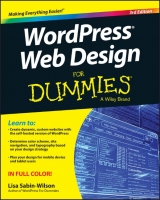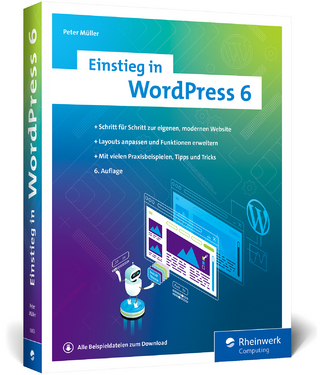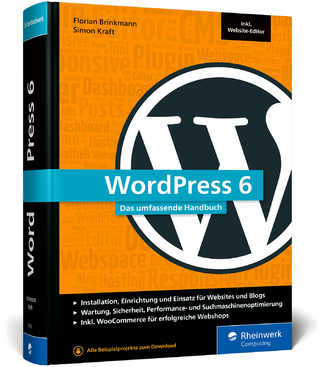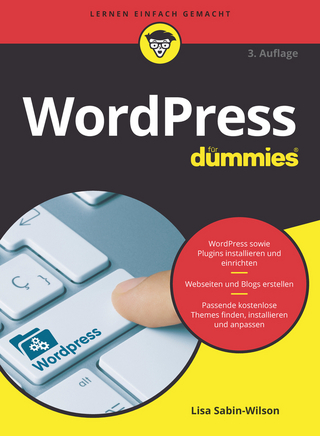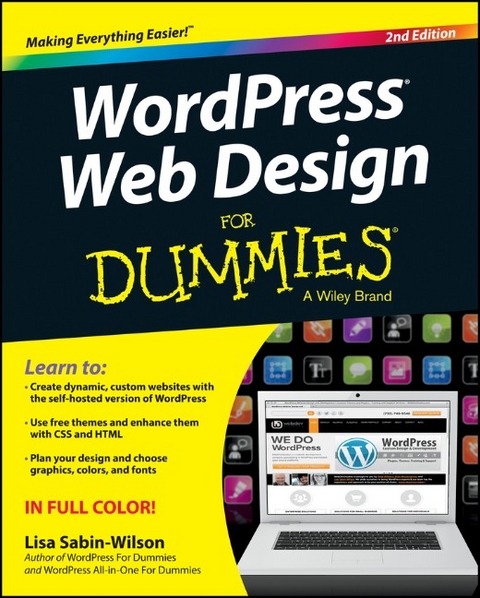
WordPress Web Design For Dummies
John Wiley & Sons Inc (Verlag)
978-1-118-54661-1 (ISBN)
- Titel ist leider vergriffen;
keine Neuauflage - Artikel merken
* Shows you how to incorporate WordPress templates, graphic design principles, HTML, CSS, and PHP to build one-of-a-kind websites * Explains how to create an effective navigation system, choose the right color palette and fonts, and select different layouts * Reveals how you can tweak existing website designs with available themes, both free and premium * Provides numerous case studies to illustrate techniques and processes, and the effects you can achieve * Discusses how you can translate your design skills into paid work Want to create cost-effective and fantastic websites with WordPress? This do-it-yourself book will get you there.
Lisa Sabin-Wilson is co-owner of WebDevStudios (http://webdevstudios.com), a company specializing in custom WordPress plugins, themes, and deployments. She's a popular conference speaker and bestselling author of WordPress For Dummies. Find her on Twitter: @LisaSabinWilson.
Introduction 1 Part I: Establishing a WordPress Foundation 5 Chapter 1: Exploring Web Design with WordPress 7 Delving Into the Differences between Blogs and Websites 8 Using WordPress as a Content Management System 11 Discovering the World of WordPress Themes 13 Checking Out Premium WordPress Themes and Frameworks 15 Getting Your Site Up and Running 16 Chapter 2: Understanding WordPress Requirements 17 Establishing Your Domain 17 Understanding domain name extensions 18 Considering the cost of a domain name 19 Registering your domain name 19 Finding a Home for Your Website 21 Examining what services web hosts offer 21 Finding a host that provides WordPress features 23 Planning for future needs 24 Being cautious about offers of unlimited space and bandwidth 25 Chapter 3: Installing WordPress on Your Web Server 27 Installing WordPress 27 Setting up the MySQL database 29 Uploading the WordPress files 31 Running the install script 33 Discovering WordPress Release Cycles 39 Understanding why you need to upgrade regularly 40 Examining release cycles 41 Keeping Track of WordPress Development 42 Chapter 4: Managing Content with WordPress 45 Archiving Content with WordPress 45 Building categories 48 Changing the name of a category 49 Creating new categories 52 Using static page parents and children 54 Customizing Permalinks 55 Making your post links pretty 56 Customizing your permalinks 57 Making sure that your permalinks work with your server 59 Syndicating Your Content with RSS Feeds 61 Introducing feed readers 61 Discovering the many WordPress RSS options 62 Using your RSS feeds with your social media accounts 63 Part II: Choosing the Right Tools 65 Chapter 5: Exploring Editors, Browsers, and FTP 67 Choosing the Right Text Editor for You 68 Notepad (Windows) 68 Notepad++ (Windows) 69 TextMate (Mac) 71 Understanding and Choosing a Web Browser 71 Discovering browsers and tools 71 Understanding cross-browser compatibility 74 Introducing File Transfer Protocol (FTP) 76 Setting Up FTP on Your Hosting Account 77 Transferring Files with an FTP Client 80 Connecting to the web server via FTP 80 Transferring fi les from point A to point B 83 Editing fi les by using FTP 83 Changing fi le permissions 84 Chapter 6: Choosing Graphics and Software Resources 87 Exploring Image Types and Formats 87 Comparing raster and vector images 88 Looking at image fi le formats 90 Exploring Graphic Design Software 92 Using raster-based software 93 Using vector-based software 97 Using Online Image-Optimization Tools 99 Finding Online Image Libraries 100 Chapter 7: Choosing Colors and Fonts 103 Understanding Color 103 Checking out the color wheel 104 Examining the RGB and hex color models 105 Creating Color Schemes with Helpful Tools 106 Exploring different color combinations 107 Finding RGB and hex codes 108 Understanding Typography Essentials 110 Exploring font styles 111 Discovering web-safe fonts for content 111 Finding and Using Fonts for Graphic Design 114 Finding the right fonts for your project 115 Installing fonts on your computer 115 Chapter 8: Planning Your Design Strategy 117 Choosing the Width of Your Website 118 Designing with a fixed width 119 Designing with a fluid width 123 Designing a responsive layout 126 Choosing the Number of Columns 129 Determining Website Navigation 131 Understanding Content Display Options 133 Testing Your Design in a Sandbox Environment 134 Creating a sandbox environment 135 Using a plugin to back up and transfer from your sandbox 137 Part III: Working with WordPress Themes 141 Chapter 9: Finding and Installing a WordPress Theme 143 Finding and Installing a Theme from the Themes Directory 144 Deciding to Use a Premium Theme 146 Chapter 10: Working with the Default Theme: Twenty Thirteen 147 Exploring the Layout and Structure 147 Customizing the Header Image 150 Selecting one of the available header images 150 Uploading your own header image 151 Including Custom Navigation Menus 154 Enhancing Your Website with Widgets 158 Understanding how widgets work 158 Adding widgets to your sidebar or footer 160 Using the Text widget 162 Adding the RSS widget 164 Chapter 11: Dissecting Themes and Templates 167 Understanding How PHP and MySQL Work Together 168 Exploring PHP Basics 168 Examining the makeup of a template tag 169 Trying out a little PHP 170 Managing Your MySQL Database 172 Viewing the Template Files in a WordPress Theme 175 Examining the Templates That Make Up a WordPress Theme 177 The stylesheet 179 The Main Index and The Loop 180 The Header template 183 The Sidebar template 187 The Footer template 187 Other template files 188 Exploring Template Tags, Values, and Parameters 188 Customizing Your Blog Posts with Template Tags 191 Putting It All Together 192 Connecting the templates 192 Using additional stylesheets 199 Chapter 12: Displaying Content with Widgets and Template Tags 201 Exploring Common Template Tags 202 Calendar 202 List pages 203 Post archives 205 Categories 207 Content types (WP-Query tag) 209 Miscellaneous but useful template tags 211 Adding New Widget Areas to Your Theme 213 Registering your widget areas 213 Adding widget areas to your template files 214 Using Template Files 215 Creating named templates 215 Creating and using template parts 216 Exploring content-specific standard templates 219 Using Page templates 220 Adding Theme Support for Built-In Features 222 Adding support for custom navigation menus 222 Adding support for custom post types 230 Adding support for post formats 238 Adding support for post thumbnails 245 Chapter 13: Understanding Parent and Child Themes 249 Customizing Theme Style with Child Themes 249 Creating a child theme 250 Loading a parent theme s style 252 Customizing the parent theme s styling 253 Using images in child theme designs 254 Modifying Theme Structure with Child Themes 259 Overriding parent template files 260 Adding new template files 260 Removing template files 263 Modifying the theme functions file 265 Preparing a Parent Theme 266 Part IV: Building Your Custom Website 269 Chapter 14: Using Basic CSS and HTML to Customize Your Site Design 271 Styling with CSS: The Basics 272 Introducing CSS 272 CSS selectors 273 Classes and IDs 274 CSS properties and values 275 Changing the Background Image or Color Used in Your Theme 277 Adding the custom background feature to a theme 277 Customizing the background 278 Changing the background using CSS 280 Defining and Positioning Your Header Image with CSS 281 Defining a background image to use as a header 282 Positioning, repeating, or scrolling your background image 282 Changing Basic Elements to Create a Unique Look for Your Site 284 Adding background colors and image effects 284 Choosing a font family, color, and size 285 Using borders in your design 287 Understanding Basic HTML Techniques to Use on Your Site 287 Inserting images 289 Inserting hyperlinks 290 Inserting lists 290 Chapter 15: Designing for WordPress as a CMS 293 Creating the Front Page of Your Website 294 Creating a static page 296 Assigning a static page as the front page 297 Tweaking the page to look like a website rather than a blog 299 Adding a Blog to Your Website 300 Creating a blank page for the blog 300 Assigning the new page as a blog 301 Creating Custom Page Templates to Achieve Different Layouts and Styles 302 Viewing the default Page template (pagephp) 303 Creating a new category Page template 304 Comparing two Page templates 306 Creating Different Sidebar and Footer Templates for Your Pages 307 Creating Custom Styles for Sticky, Category, and Tag Posts 308 Chapter 16: Enhancing Your Website with Plugins 311 Installing WordPress Plugins via the Dashboard 312 Finding free plugins 312 Installing and activating a plugin 313 Installing Plugins Manually 316 Exploring E-Commerce Plugins to Use on Your Site 316 Understanding what you can do with e-commerce plugins 317 Examining some recommended plugins 317 Creating Photo Galleries or Portfolios 321 Inserting images into your page or post 321 Adding image styles to your stylesheet 326 Inserting a photo gallery 327 Creating Web Forms for Your Site with Plugins 332 Exploring different types of forms you can use on your site 333 Helpful plugins to create forms 334 Building a Social Community with BuddyPress 337 Using Plugins to Integrate Popular Social Networks with Your Blog 339 Integrating Twitter with Twitter Tools 339 Integrating Facebook with Wordbooker 340 Part V: The Part of Tens 343 Chapter 17: Ten Powerful Plugins for WordPress 345 All in One SEO Pack 345 BackupBuddy 346 WP-Print 346 PluginBuddy Mobile 347 ShareThis 348 Subscribe to Comments 348 WordPresscom Stats 349 WP Security Scan 349 WP Super Cache 349 WPMU Premium 350 Chapter 18: Ten Well-Designed Sites That Use WordPress as a CMS 351 IconDock 351 Kate Rusby 352 Katy Perry 353 LIVESTRONG 353 Mozilla Labs 354 MSNBC 354 Time Healthland 355 WebDevStudios 356 WeGraphics 357 WordPressorg 358 Index 359
| Zusatzinfo | Illustrations |
|---|---|
| Verlagsort | New York |
| Sprache | englisch |
| Maße | 189 x 231 mm |
| Gewicht | 868 g |
| Themenwelt | Informatik ► Web / Internet ► Content Management Systeme |
| ISBN-10 | 1-118-54661-X / 111854661X |
| ISBN-13 | 978-1-118-54661-1 / 9781118546611 |
| Zustand | Neuware |
| Informationen gemäß Produktsicherheitsverordnung (GPSR) | |
| Haben Sie eine Frage zum Produkt? |
aus dem Bereich
